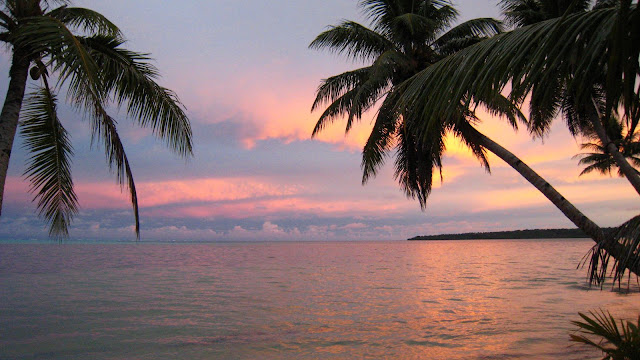 Yap
Yap,
ahh, Yap. This place was a little paradise for us - an oasis of comfort and enjoyment after 5 months of hardcore travel. After only 25 days here, we felt like we’d been here for years. For those who may not be familiar with Pacific Ocean geography, Yap is a small group of islands in the Federated States of Micronesia, south east of the Philippines. We read about this place in the book “1,000 Places to See Before you Die” and were intrigued by its preservation of traditional culture and giant manta rays.
We
weren’t sure what to expect before we arrived –
didn’t know if we’d be reduced to complete boredom with almost a month here, or find we'd never want to leave. Our experience was somewhere in between - perhaps we
couldn’t stay here our whole lives, but we certainly had no problem enjoying a month here and probably could have been pretty content here for much longer.
Overall, our experience in Yap was a mix of local culture, expat culture and “recharging our travel batteries." We were very intentional in our first few days to get out and meet people so we could get integrated and involved in the local scene. Since we have experienced quite a lot in the past month, and don’t want to bore you with the day to day, we will share our highlights with you...
Island Lifestyle
Pretty early on, we had to adjust to what is widely known as “island” time. Island life moves significantly slower than the Western world, especially the USA. At first, you feel a bit of guilt for being so unproductive – sleeping in everyday, spending lots of time just hanging out, watching movies, reading a book, meandering around town, etc. But after awhile, you can feel yourself finally starting to relax – learning to go with the flow and actually enjoy the rest from a faster pace of life.
Now, the downside with island time is that nothing is ever really on time, and planning and scheduling is pretty much ad
hoc. We had originally hoped to catch the local ship to the outer islands (why we planned so much time here), but the ship’s schedule
wasn’t determined until just before our arrival and we missed the boat by 3 days. And of course, they
didn’t have a schedule for the next trip yet. In Yap, you just kinda have to wait around and hope that things will fall into place. Unfortunately for us, it
didn’t work out to go farther afield, but not to worry, we found plenty of nothing to fill our time and enjoy the main island. :)
The other thing you learn about island life is that the weather is a huge determining factor in what you can, and can’t do. When we found we
couldn’t go to the outer islands by ship, we decided to try to go by the small missionary plane. But, alas, it
wasn’t meant to be. On the day of our flight, a small tropical storm was forming and we
couldn’t fly. Weather also played a role in our hiking, biking and kayaking plans...meaning we either couldn't go when planned, or we got wet and muddied. Don’t be mistaken, there was a lot of sun and it was HOT here, but torrential downpours did have a way of creeping up on you just when you planned to do something active.
And the last point to mention about island life...what you can and can not buy depends on what the ship brings in. And ships don't always come frequently. This means the island may go for 2 months without flour (as when we were there) or other food and retail goods. And at times, you have an abundance of random goods. You just have to learn to make do with what you have, improvise, and learn the tricks of the locals on using local food and products for all your needs.
Hanging With the Local Youth
On our second day in Yap, we volunteered to help out one of the high school classes to build a
Koiang (a traditional hut for hanging out and relaxing). We learned to peel betel nut trees for the floor boards, construct the frame from large bamboo poles and weave palm leaves to make shingles for the roof. Most the students were about 17, so we chatted a lot about pop culture, school and a bit about Yap culture.
While the boys were a bit on the shyer side, we did have a good connection with a couple of the girls –
Jerlyn and
Zillah. They invited us to meet them in town later that week for lunch after school and we ended up meeting them every Friday for lunch. We also went to their village on two Saturdays to hang out. The first Saturday we had a picnic lunch at the sea shore before attending their Catholic church service. It was very interesting to attend a local church service in
Yapese. While we
didn’t understand too much of what they were saying, it was fun to observe the combination of Catholic traditions with local ones; for example, the altar boys wore traditional
Yapese dress and the priest had a flower lei made for him.

The following Saturday, we invited some expat (foreign) friends and the girls invited some of their friends to meet again at the sea shore for a picnic with local food, swimming, football and hanging out. Since we
didn’t have as much of an opportunity as we had hoped to mix with the traditional culture and go to the outer islands, it was nice to have a chance to get to know some of the local teens.
Yap Traditions and CustomsWe learned many things about
Yap's culture while staying here and would be happy to share more details with anyone interested. Here are just a few cool tidbits...
- The Island of Stone Money - All across the island, you will find huge, flat stone slabs with a hole in the center known as stone money. The money was brought to the island from Palau by Yapese ancestors and its value is determined not only by size, but b
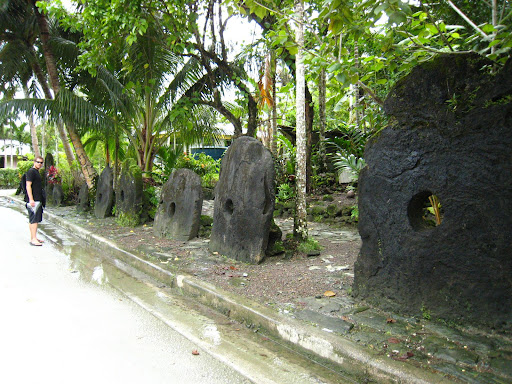 y the story of its journey to the island (e.g., how difficult it was to get it to Yap, how many people died in transporting it). Since the US dollar is now the formal currency in Yap, one would think stone money would be something of the past, not just a decoration...not so. These stones still retain much value to the islanders and are still used to pay debts, exchanged between families or villages as payment, etc. This doesn't mean they pick up the stones and deliver them to each other. Usually, they just tell the other party where the money is and it's agreed that the ownership has changed hands. There is even stone money at the bottom of the ocean you can see while scuba diving. And yes, even this money is still owned and has value. Pretty cool.
y the story of its journey to the island (e.g., how difficult it was to get it to Yap, how many people died in transporting it). Since the US dollar is now the formal currency in Yap, one would think stone money would be something of the past, not just a decoration...not so. These stones still retain much value to the islanders and are still used to pay debts, exchanged between families or villages as payment, etc. This doesn't mean they pick up the stones and deliver them to each other. Usually, they just tell the other party where the money is and it's agreed that the ownership has changed hands. There is even stone money at the bottom of the ocean you can see while scuba diving. And yes, even this money is still owned and has value. Pretty cool.
- Betel Nut - These little green nuts (about the size of a large grape, but hard shell) are all the rage on the island. The locals chew them constantly - you split them in half, pick out the middle, pour in a bit of lime (crushed coral) powder and maybe a bit of tobacco soaked in vodka and wrap them in a small piece of pepper leaf and then chew them. The effect is a light buzz and very red spit. For most islanders, this is a life-long habit that eventually turns your teeth red and then black. But they LOVE it! I, however, was not such a fan!
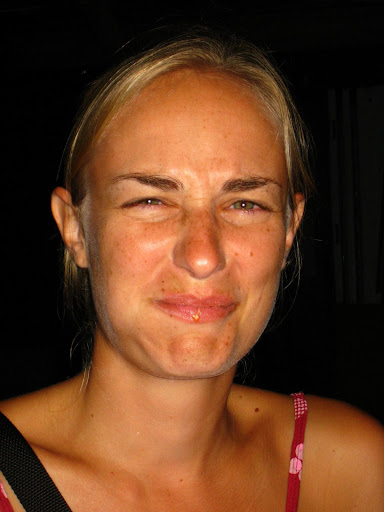
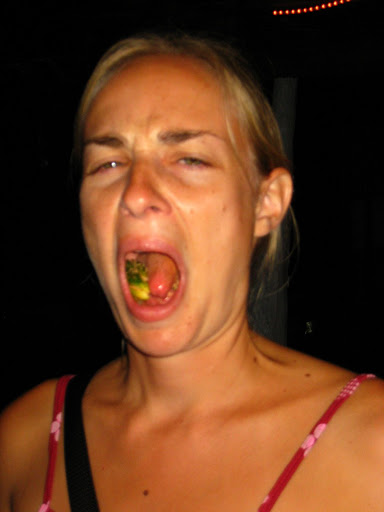

- Men's Houses - Most major villages have a men's house - a large house made
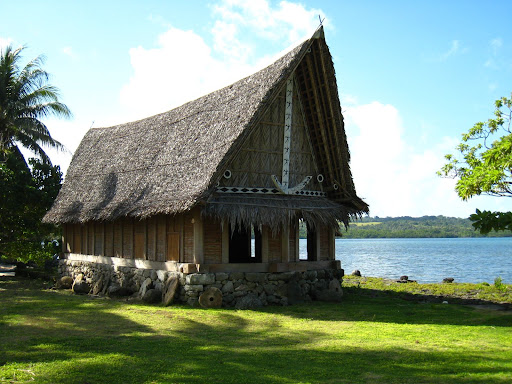 from island materials (see the many photos we have of these). The houses are used primarily for meetings or hanging out, and in the past adolescent boys went through a number of traditional coming of age rituals here. And of course, no girls aloud.
from island materials (see the many photos we have of these). The houses are used primarily for meetings or hanging out, and in the past adolescent boys went through a number of traditional coming of age rituals here. And of course, no girls aloud.
Scuba DivingWe were lucky to work out a good deal with a local dive shop -
Beyond the Reef - because of our extended stay and did about 10 dives while in Yap. While the diving here is not as
spectacular as
Palau (due in part to Typhoon
Sudal in 2004 - the corals are slowly growing back and should b
e more amazing within a few years), the island does have some really neat sea life. The most notable feature of Yap diving is the
gigantic Manta Rays that frequent the natural cleaning stations. We saw a few of them while diving and they are quite
majestic creatures. There are also a ton of reef sharks - on one dive we saw a school of 15 baby reef sharks. And there are also the extremely tiny, but colorful, mandarin fish who come out of the corals at dusk to mate. We did a special dive just to observe their little romantic dance and it was pretty amazing. We took our camera on most dives, so to see some of what we saw in the deep blue, check out our photos.
A Little Slice of Home
After so many months on the road, you begin to miss some of the little things that make home, home. While in Yap, we were able to have many of our little cravings satisfied and get fully re-charged for the next leg of our journey.
We rented our own little apartment for the month and had our own

kitchen to cook (and bake - 3 cakes!). They even sold some American favorites at the store, so we had Mac&Cheese, tacos, pancakes, and
spaghetti. Plus, our friend Dieter cooked us
lasagna and chicken curry! We had a TV and
dvd player and caught up on new releases and old favorites - we probably watched 30+ movies! We got into a regular workout routine (have to get in shape for our wedding!) and worked out almost everyday for an hour and went to the island's sport complex a number of times.
We had our own pack of dogs just outside the apartment - "Queen Bitch" as she's called was the ruler of the pack, her cute pup
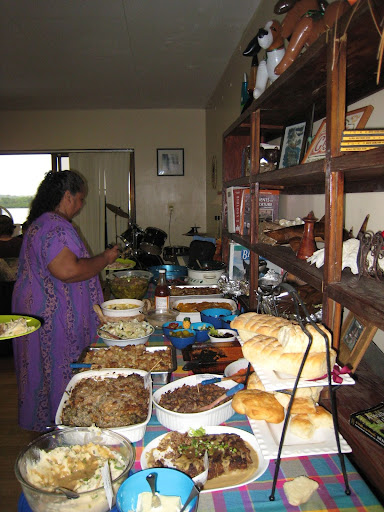 py
py "Meaty" was another favorite and the third wheel was "Tuna." They were there to greet us and love us up every time we came home...and of course we had to feed them our dinner scraps.
We even had an American family to hang out with to watch football (got to see the
USC football game on Thanksgiving day!), have home cooked meals with on
occasion, and were even invited to their Thanksgiving feast that included all the traditional trimmings - turkey, mashed potatoes, cranberry sauce, sweet potatoes, green bean casserole and pumpkin and pecan pie, YUM!
A Busy Social Life
Yap has a small, but close-knit, expat community (expat = foreigner who has left their own country to live either permanently or temporarily in a foreign country). The bi
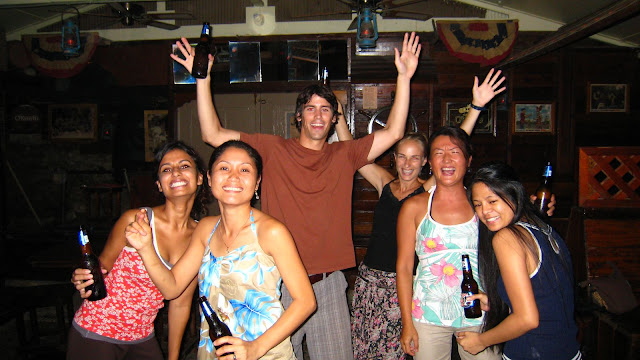 ggest
ggest town in Yap is
Colonia with a population of around 1,100...just one main street with a few businesses and small hotels. Within the first week, we had met a good number of the foreigners living on the island a
nd developed a great group of friends. This was one of our favorite aspects of our time on the island - actually staying somewhere long enough to get to know people. We attended and hosted a number of dinner parties, went out every Friday night dancing, had regular drinks at the
Mnuw (the bar in an old ship at the
Manta Ray Bay Hotel), and a variety of other social activities. We met many great friends on the island...
- Matt and Seema - an awesome couple from Indiana who we often shared meals with and who shared our love for the three dogs who lived at our apartments, especially the cute puppy they named "Meaty"

- The Hermes family - who became our surrogate family from Minnesota. There is Rick and Cindy and their three teenage boys Chris (age 14) and Chuck and Tony (identical twins age 17). We spent many afternoons watching football at their house and Cindy and I would chat for hours.

- Garrett - a former Peace Corps member who decided to stick around after his assignment (island life is a bit addictive). This guy is virtually a local and is the person to know to figure out anything you want to do/see on the main or outer islands.

- Brian and Bri - a couple raised on islands (Hawaii and Marshall Islands) who we actually bumped into in Palau. Thanks to their advice and contacts, we were able to get to know people quickly.
- Jan - from Belgium, but raised in Africa. Jan manages the Manta Ray Bay Hotel dive shop and while he is a work horse, he always finds time for a glass of red wine and a nice chat in the evenings. Not to mention his knack for demonstrating his own style of "African" dancing late on Friday nights ;)

- Arild - from Norway and our happy hour buddy at the Mnuw.
- Dieter and Minnie - Dieter is from Austria and formerly managed another local dive shop, but currently works as an architect on the island. He is an amazing cook and often the life of the party. Minnie, his girlfriend, is from the Philippines and is one of the sweetest people on the island.

- Claus, Richard and Evie - All friends visiting Dieter while we were there. Claus from Germany and Richard and Evie from Austria. We enjoyed their company at dinner parties, nights out on the island and diving.
We will truly miss the friends we made on Yap and sincerely hope we will cross paths with them again. If it hadn't been for them, our time there would not have been nearly as enjoyable or memorable! In fact, sitting here writing this blog in New Zealand, we already are missing our little Yap home.
wedding ceremony and found numerous other ways to spoil us and make us feel like part of the family. And because so many Cook Islanders were home for the holidays, family members were constantly dropping by to fill the house with activity and conversation. It’s was such a pleasure to be around a big family who welcomed us with open arms. We learned so much from our conversations with Edna, Mama, Atua and Mata about the island culture, ancestry ties and way of life. We couldn’t have planned it better!
ing, we spent a good part of our first week on the island getting ready for the wedding ceremony on Jan 1. We had booked most everything online – so were hoping with fingers crossed that the arrangements would live up to our expectations. And we weren't disappointed! We stopped by the 5 beach houses we rented for the occasion and they are in a fabulous location on a lovely beach. There are BBQ areas, picnic tables, kayaks, snorkel gear and the houses are well equipped with kitchen stuff, TVs and DVDs, and even a small stereo. The best part are the wooden decks and dining tables that overlook the beach and the ocean. The setup is perfect for a memorable holiday and wedding!
around the entire island and stopping at all the little shops and markets to look for some fun souvenirs to get for everyone – and a few goodies for ourselves too. We had only one little incident with the motorbike…when I ran us into a bush while turning (going at a very slow speed thank goodness) and we tipped over. I got a skinned knee and mom was a bit sore, but we recovered pretty well. After our little accident, we decided the first bike we had rented was too big and went and got me a smaller one that I could handle better. And I'm happy to say that with a bit more practice, I had no further run ins…though I did still make Eric (who’s a much better driver) take mom when the three of us would go for an outing.
While we had hoped to have Eric’s dad, Jeff, do the legal and symbolic pieces of the wedding ceremony, we found out on our arrival that it would entail getting Jeff licensed in the
arie who gave us quite the hard time. But to our relief, she did agree to marry us and even cracked a brief smile and a joke – telling Eric he would need to clean up and shave before she’d marry us.
ic and I decided to buy me a simple white, linen dress for the occasion and we got Eric a proper island shirt complete with palm trees and beach scene. Mama made us flower leis – one for Eric and a head ei for me. And she made a chain of flowers for the car, which Edna decorated. The time was set for Thursday at 3PM. We spent the morning relaxing and contemplating the fact that we were about to legally “sign our lives away.” It was a stress free day…until about 15 mins before we needed to leave when we realized we had a few small alterations to my new dress. Mom saved the day with some needle and thread in record time and we were out the door and on the way.
. Stoic Marie instructed us to sit across from her with one witness on each side…Mama Turi took a seat at the end of the table to observe from a distance. After the very formal introduction, we were asked to rise, clasp right hands and repeat a series of very serious and legal sounding vows (e.g., “I solemnly declare there is no legal reason to my knowledge that I should not marry you”). We were overcome with emotion at the importance of this moment, but also couldn't help cracking a smile at the contrast of the very legal sounding vows to the very personal ones we planned to say to each other on Jan 1. We laughed, we got a bit teary, we exchanged rings, we embraced, and of course Eric kissed his bride (even though Marie didn’t instruct to do so). Mama Turi was streaming tears at the end of the table, and of course so were my mom and Edna…and I think Marie was even pleased to see that we took our commitment seriously. We signed the paperwork, got the international stamps to make it legal worldwide and completed the “official” part of our marriage.